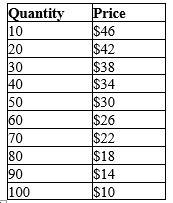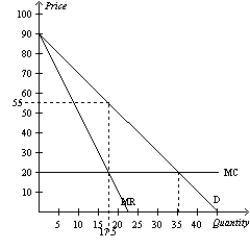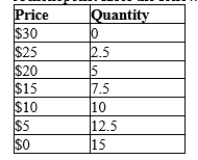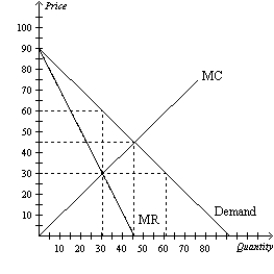A) promote monopolies.
B) are intended to serve private interests, not the public's interest.
C) have costs but not benefits.
D) eliminate the need for firms to engage in research and development.
F) A) and C)
Correct Answer

verified
Correct Answer
verified
Multiple Choice
Scenario 15-8 Mega Media Cable TV is able to purchase an exclusive right to sell a premium sports channel in its market area. Let's assume that Mega Media pays $100,000 a year for the exclusive marketing rights to the sports channel. Since Mega Media has already installed cable to all of the homes in its market area, the marginal cost of delivering the sports channel to subscribers is zero. The manager of Mega Media needs to know what price to charge for the sports channel service to maximize her profit. Before setting price, she hires an economist to estimate demand for the sports channel. The economist discovers that there are two types of subscribers who value premium sporting channels. First are the 3,000 die-hard sports fans who will pay as much as $150 a year for the new channel. Second, the premium sports channel will appeal to 20,000 occasional sports viewers who will pay as much as $25 a year for a subscription to it. -Refer to Scenario 15-8. If Mega Media Cable TV is able to price discriminate, what would be the maximum amount of profit it could generate?
A) $950,000
B) $850,000
C) $400,000
D) $350,000
F) None of the above
Correct Answer

verified
Correct Answer
verified
Multiple Choice
Marginal revenue for a monopolist is computed as
A) average revenue divided by quantity sold.
B) average revenue times quantity divided by price.
C) total revenue divided by quantity sold.
D) change in total revenue per one unit increase in quantity sold.
F) A) and C)
Correct Answer

verified
Correct Answer
verified
Multiple Choice
Scenario 15-3 A monopoly firm maximizes its profit by producing Q = 500 units of output. At that level of output, its marginal revenue is $30, its average revenue is $60, and its average total cost is $34. -Refer to Scenario 15-3. At Q = 500, the firm's profit is
A) $13,000.
B) $15,000.
C) $17,000.
D) $30,000.
F) B) and C)
Correct Answer

verified
Correct Answer
verified
Multiple Choice
A monopoly market is characterized by
A) many buyers and sellers.
B) "natural" products.
C) barriers to entry.
D) a Nash equilibrium.
F) A) and C)
Correct Answer

verified
Correct Answer
verified
Multiple Choice
Suppose when a monopolist produces 50 units its average revenue is $8 per unit, its marginal revenue is $4 per unit, its marginal cost is $4 per unit, and its average total cost is $3 per unit. What can we conclude about this monopolist?
A) The monopolist is currently maximizing profits, and its total profits are $200.
B) The monopolist is currently maximizing profits, and its total profits are $250.
C) The monopolist is not currently maximizing its profits; it should produce more units and charge a lower price to maximize profit.
D) The monopolist is not currently maximizing its profits; it should produce fewer units and charger a higher price to maximize profit.
F) C) and D)
Correct Answer

verified
Correct Answer
verified
Multiple Choice
If a monopoly market were to be transformed into a competitive market, the result would be that
A) market output would increase.
B) the market would be efficient, once the market reached the competitive output.
C) the deadweight loss from the monopoly would be eliminated.
D) All of the above would be true.
F) A) and C)
Correct Answer

verified
Correct Answer
verified
Multiple Choice
Figure 15-7  -Refer to Figure 15-7. A profit-maximizing monopolist would incur total costs of
-Refer to Figure 15-7. A profit-maximizing monopolist would incur total costs of
A) $81.
B) $120.
C) $144.
D) $240.
F) All of the above
Correct Answer

verified
Correct Answer
verified
Short Answer
Table 15-1  -Refer to Table 15-1. The marginal revenue becomes negative with the production of which unit of output?
-Refer to Table 15-1. The marginal revenue becomes negative with the production of which unit of output?
Correct Answer

verified
Correct Answer
verified
Short Answer
Figure 15-1  -Refer to Figure 15-1. How much deadweight loss results if this single-price monopolist profit-maximizes?
-Refer to Figure 15-1. How much deadweight loss results if this single-price monopolist profit-maximizes?
Correct Answer

verified
Correct Answer
verified
True/False
A monopolist's supply curve is vertical.
B) False
Correct Answer

verified
Correct Answer
verified
Multiple Choice
When a monopolist reduces the quantity of output it produces and sells, the
A) price of its output increases.
B) price of its output remains constant.
C) price of its output decreases.
D) profits for the firm always decrease.
F) A) and B)
Correct Answer

verified
Correct Answer
verified
Multiple Choice
Table 15-4
A monopolist faces the following demand curve:  -Refer to Table 15-4. If the monopolist increases production from 2.5 to 5 units, what is its marginal revenue?
-Refer to Table 15-4. If the monopolist increases production from 2.5 to 5 units, what is its marginal revenue?
A) $100
B) $37.5
C) $15
D) $2.50
F) B) and D)
Correct Answer

verified
Correct Answer
verified
True/False
The deadweight loss for a monopolist equals one-half of its profits for any given level of output.
B) False
Correct Answer

verified
Correct Answer
verified
Multiple Choice
A monopolist maximizes profits by
A) producing an output level where marginal revenue equals marginal cost.
B) charging a price that is greater than marginal revenue.
C) earning a profit of (P - MC) x Q.
D) Both a and b are correct.
F) B) and C)
Correct Answer

verified
Correct Answer
verified
Multiple Choice
Table 15-3
Consider the following demand and cost information for a monopoly.  -Refer to Table 15-3. The marginal revenue of the 2nd unit is
-Refer to Table 15-3. The marginal revenue of the 2nd unit is
A) $10.
B) $15.
C) $20.
D) $25.
F) A) and D)
Correct Answer

verified
Correct Answer
verified
Multiple Choice
A patent gives the inventor monopoly control over the patented good. Patents also
A) lead to lower prices for goods.
B) create incentives to develop new products.
C) lead to an increase in the number of producers of the patented good.
D) lead to increased entry into the market for the patented good.
F) A) and B)
Correct Answer

verified
Correct Answer
verified
Multiple Choice
Which of the following statements is correct? Monopolies are socially inefficient because they (i) charge a price above marginal cost. (ii) produce too little output. (iii) earn profits at the expense of consumers. (iv) maximize the market's total surplus.
A) (iii) only
B) (iii) and (iv) only
C) (i) and (ii) only
D) (i) , (ii) , (iii) , and (iv)
F) A) and C)
Correct Answer

verified
Correct Answer
verified
Multiple Choice
A firm that is the sole seller of a product without close substitutes is
A) perfectly competitive.
B) monopolistically competitive.
C) an oligopolist.
D) a monopolist.
F) All of the above
Correct Answer

verified
Correct Answer
verified
Multiple Choice
Figure 15-15  -Refer to Figure 15-15. To maximize its profit, a monopolist would choose which of the following outcomes?
-Refer to Figure 15-15. To maximize its profit, a monopolist would choose which of the following outcomes?
A) Q = 30 and P = 30
B) Q = 30 and P = 60
C) Q = 45 and P = 45
D) Q = 60 and P = 30
F) A) and C)
Correct Answer

verified
Correct Answer
verified
Showing 421 - 440 of 662
Related Exams